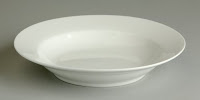The uses of napkin:
The basic function of the napkin is to wipe your fingers and blot your mouth.
- After sitting, unfold your napkin and place it in your lap (don't tuck it in your collar) after the host or hostess has placed his or her napkin in their lap.
- Small napkins are used an informal meals. They are completely unfolded.
- Use the napkin to blot your lips as needed and before taking a drink.
- Place your napkin in your chair if leaving the table during the meal.
- When the meal is completed, the napkin is folded loosely and placed to the left of your plate (or in the center of your place setting if your plate has been cleared).
There are many types of napkin folding.
1. The roses
i.
First, lay the napkin in front
of you.
ii.
Fold the napkin bottom side to
the middle and upper fabric side to the middle.
iii.
Make sure the width of the
napkin is the same for both.
iv.
Without changing position, turn
back the napkin.
v.
Fold the side of the napkin at
the top match to the bottom side.
vi.
Fold the napkin right side 1/4
to the left.
vii.
Repeat step 6 for the left side
of the napkin. Both folds must meet in the middle.
viii.
Fold 45 degree the top right
corner of the napkin meets the bottom edge of fabric folds similar to a
triangle shaped the same.
ix.
Repeat steps 8 to fold the
napkin on the left.
x.
Hold the folded fabric edges on
the right and left and fold back.
xi.
Insert the right side of the
napkin edges into the fabric edges left.
xii.
Make it tidy.
3. The arum lily.
i. Fold napkin bringing bottom up to top.
ii. Fold corners to top.
iii. Fold bottom point up to 1” below top.
iv. Fold point back onto itself.
v. Fold each of points at top down one layer of top point and tuck under base fold.
vi. Turn napkin over and tuck left and right sides into each other.
vii. Open base and stand.
1.
The candle.
i.
Fold napkin in half diagonally.
ii.
Fold down base 1/3 way.
iii.
Turn napkin over and roll from
bottom to top.
iv.
Tuck corners inside cuff at
base of fold and stand.
v.
Turn one layer of point down
and set on base.
2.
Bird of paradise.
i.
Fold napkin in half and in half
again.
ii.
Then fold in half diagonally
with points on the top and facing up.
iii.
Fold left and right sides down
along center line turning their extended points under.
iv.
Fold in half on long dimension
with edges facing out.
v.
Pull up points and arrange on a
fabric surface.
4.
The crown.
i.
Fold napkin in half diagonally.
ii.
Fold corners to meet at top
point.
iii.
Fold bottom point 2/3 way to
top and fold back onto itself.
iv.
Turn napkin over bringing
corners together, tucking one into the other.
v.
Peel two top corners to make
crown. Open base of fold and stand upright.







